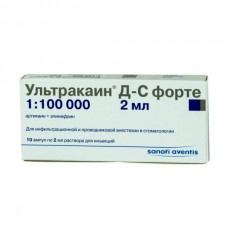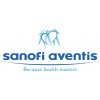Expiration date: 12/2025
Structure and Composition:
1 ml injection solution contains 40 mg articaine hydrochloride and epinephrine hydrochloride and 12 mg 6 (A-C ultrakain forte) and sodium metabisulphite 0.5 mg in 1.7 ml on the cartridge, in multiples of 100 items. or 2 ml ampoules, in pack of 10.
Pharmachologic effect:
Membrane depolarization, blocking nerve endings and prevents the perception of stimuli and the nerve impulses.
Pharmacokinetics:
It has a high diffusion capacity with submucosal administration in the mouth. Protein binding is 95%. T1 / 2 - 25.3 min. In minimally crosses the placental barrier, little is excreted in breast milk.
Clinical Pharmacology:
The action begins quickly - 1-3 minutes. The duration of anesthesia is not less than 45 min (articaine D-C) and not less than 75 minutes (A-C articaine forte). Wound healing proceeds without complications due to good tolerability and minimum tissue vasoconstrictor activity. Due to the low content of adrenaline in the preparation of its effect on the cardiovascular system it is expressed little (almost no marked increase in blood pressure and increased heart rate). It has low toxicity.
Indications:
Infiltration and conduction anesthesia in dentistry during the following manipulations: uncomplicated removal of one or more teeth, preparation of cavities and tooth for a crown (articaine D-C) transactions on the mucous membranes or bone, requiring a more pronounced effect of ischemia, the operation on the tooth pulp (amputation and the extirpation of pulp), removal of broken teeth (osteotomy), tooth extraction, the affected apical periodontitis, Caldwell-Luc operation, percutaneous osteosynthesis, cystectomy, mukogingivalnye operations radiectomy, preparation of cavities and tooth for a crown in patients with sensitive teeth (articaine D-C forte).
Contraindications:
Hypersensitivity, paroxysmal tachycardia, and others. Tachyarrhythmias, angle-closure glaucoma, asthma (in patients with hypersensitivity to sulfite).
Application of pregnancy and breastfeeding:
Acceptable. During pregnancy, preference should be given ultrakain D-C.
Side effect:
Impaired consciousness (up to the loss), respiratory arrest, muscle tremors, seizures, nausea, vomiting, a drop or increase in blood pressure, tachycardia or bradycardia, arrhythmia blurred in the eyes, transient blindness, diplopia, headache, allergic reactions (redness, itching, conjunctivitis , rhinitis, angioedema varying severity, including swelling of the upper and / or lower lips and / or cheeks, the glottis with the difficulty of the act of swallowing, hives, difficulty breathing), all these phenomena may progress to anaphylactic shock local reactions - swelling or inflammation in the injection site, and in some cases - inadvertent intravascular injection may lead to the development of ischemic zones in the injection site, sometimes progressing to tissue necrosis. Side effects due to the action of epinephrine (tachycardia, arrhythmia, increased blood pressure) occur rarely in low - 1: 200000 (0.5 mg / 100 ml) and 1: 100,000 (1 mg / 100 mL) concentrations of epinephrine. Nerve damage (up to the development of facial paralysis) occur only in violation of the injection technique.
Drug Interactions:
Hypertensive effect is enhanced by adrenaline tricyclic antidepressants and MAO inhibitors. Increased risk of hypertensive crisis and severe bradycardia against the background of non-selective beta-blockers.
Dosage and administration:
The dose is determined individually, taking into account the severity and duration of surgery. In uncomplicated removal of the upper jaw teeth (no inflammation) is carried articaine infiltration anesthesia at a dose of 1.7 ml (per tooth) may in some cases require additional administration from 1 to 1.7 ml of the drug to achieve full anesthesia. In most cases there is no need to carry out anesthetic palatal access to anesthesia of palatal sections and suturing to create palatal depot needs about 0.1 ml of anesthetic injection. When you delete several adjacent teeth number of injections can usually be limited. In the case of the removal of mandibular premolars (in the absence of inflammation) can be dispensed with mandibular anesthesia (infiltration anesthesia provided by injection of 1.7 ml per tooth is usually sufficient, if necessary, may further introduction of 1-1.7 ml of the anesthetic, and with no effect - blockade of the mandibular nerve). For oral preparation or a preparation of any tooth crown (except for the lower molars) is administered in a dose of from 0.5 to 1.7 ml for each tooth type infiltration anesthesia facially. When performing a medical procedure may be administered to adults to 7 mg / kg body weight. The dose of 500 mg (12.5 ml injection solution) is well tolerated during aspiration prior to injection of the sample in order to eliminate the possibility of intravascular injection (for its implementation is most suitable syringe "Iunidzhet K» for the cartridge).
Overdose:
At the first signs of side or toxic effect (dizziness, restlessness, impaired consciousness) immediately stop the injection and put the patient in a horizontal position requires careful monitoring of hemodynamic parameters (heart rate, blood pressure) and airway. Even if symptoms seem severe, it is necessary to prepare everything necessary for the on / in infusion and at least spend venipuncture. Depending on the degree of respiratory failure should be given oxygen, administer artificial respiration ( "mouth-to-nose") and, if necessary, endotracheal intubation with controlled ventilation. The use of medications contraindicated analeptic of the central action. When involuntary muscle twitching or generalized convulsions is shown in / with the introduction of barbiturates or short-acting (under the control of hemodynamic and respiratory, oxygen supply and at the same time / in a liquid infusion). In severe circulatory disorders and shock injection of the drug should be discontinued, ensure patient horizontal position with raised legs to hold oxygen inhalation and in / in infusion of balanced electrolyte solutions and plasma substitutes, in / enter glucocorticoids (250-1000 mg methylprednisolone). In the case of threatening vascular collapse and growing bradycardia enter in / 25-100 ug epinephrine (0.25-1 ml solution containing 100 micrograms / ml slow controlled rate and blood pressure) should not be given more than 100 mg of epinephrine (1 ml ) 1 times. Severe tachycardia and tachyarrhythmia can be removed using anti-arrhythmic drugs (but not non-selective beta-blockers). An increase in blood pressure in patients with hypertension, peripheral vasodilators should be used.
Precautionary measures:
You can not enter a / c, injected into the area of ??inflammation. In patients with cholinesterase deficiency should be used only for urgent reasons. In diseases of the cardiovascular system (chronic heart failure, a pathology of the coronary vessels, angina, dysrhythmia, myocardial infarction, hypertension), cerebrovascular disorders with the presence of paralysis in history, chronic bronchitis, emphysema, diabetes, hyperthyroidism, expressed concern advisable the use of a preparation containing a smaller amount of adrenaline. Not recommended combined with non-selective beta-blockers.
Special instructions:
It is necessary to individually decide on the admission of the patient to the control of a vehicle or operating machinery.



